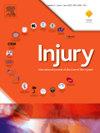Intraoperative frozen section analysis for detection of fracture-related infection in nonunion of the upper limb. Diagnostic accuracy study
IF 2.2
3区 医学
Q3 CRITICAL CARE MEDICINE
Injury-International Journal of the Care of the Injured
Pub Date : 2025-02-01
DOI:10.1016/j.injury.2024.112139
引用次数: 0
Abstract
Introduction
During revision surgery for the management of patients presenting with long-bone upper extremity nonunion, it is crucial to rule out fracture-related infection (FRI). This is especially true if there are clinical signs suggestive of FRI, or if there is a history of prior FRI, open wound fracture, or surgery. This study aimed to determine the efficacy of frozen section analysis (FSA) in providing real-time diagnosis of FRI in patients with upper-limb long-bone nonunion undergoing revision surgery.
Patients and Methods
We included previously surgically treated patients who underwent revision surgery for chronic/late-onset nonunion of the long bones of the upper limbs over a 9-year period. We retrospectively applied the FRI criteria to identify eligible patients and recorded their clinical features and demographic characteristics. In all included patients, samples for microbiological analysis and FSA were collected simultaneously during revision surgery. Patients were categorized according to intraoperative culture results as having aseptic or infected nonunion. The sensitivity, specificity, positive and negative predictive values, and accuracy of FSA test were calculated and compared using microbiological analysis as the reference standard test. The concordance rate between FSA and definitive histopathology was also determined.
Results
Sixty-two patients who were surgically treated for nonunion of the arm or forearm were included in this study. Septic nonunion was diagnosed intraoperatively in 9 patients based on FSA findings, while microbiological analysis confirmed septic nonunion in 8 patients. The sensitivity and specificity of FSA were 88 % (95 % confidence interval [CI] [47, 100]) and 96 % (95 % CI [87, 100]), respectively. Positive and negative predictive values were 78 % (95 % CI [47, 93]) and 98 % (95 % CI [89, 100]), respectively, with an overall test accuracy of 95 % (95 % CI [87, 99]). Cohen's Kappa coefficient between FSA and definitive histopathology was 0.74 (95 % CI [0.5, 1]).
Conclusions
FSA showed high sensitivity and specificity for the detection of active infection during revision surgery for nonunion of the upper limb. Owing to its high negative predictive value, it can reliably rule out active infections during revision surgery. Since the results are obtained immediately during revision surgery, this approach offers the significant advantage of enabling real-time decision-making.
术中冰冻切片分析检测上肢骨不连骨折相关感染。诊断准确性研究。
在对上肢长骨不愈合患者进行翻修手术时,排除骨折相关感染(FRI)是至关重要的。如果有提示FRI的临床症状,或者有FRI、开放性伤口骨折或手术史,这一点尤其正确。本研究旨在确定冷冻切片分析(FSA)对接受翻修手术的上肢长骨不连患者FRI的实时诊断效果。患者和方法:我们纳入了既往手术治疗的9年以上上肢长骨慢性/晚发型不连翻修手术的患者。我们回顾性地应用FRI标准来确定符合条件的患者,并记录他们的临床特征和人口统计学特征。在所有纳入的患者中,在翻修手术期间同时收集微生物分析和FSA样本。根据术中培养结果将患者分为无菌性或感染性骨不连。以微生物学分析作为参考标准试验,计算比较FSA检测的敏感性、特异性、阳性预测值和阴性预测值以及准确性。同时测定了FSA与最终组织病理学的符合率。结果:本研究纳入了62例因手臂或前臂骨不连而接受手术治疗的患者。9例患者术中根据FSA检查结果诊断为脓毒性骨不连,8例患者经微生物学分析证实为脓毒性骨不连。FSA的敏感性为88%(95%可信区间[CI][47, 100]),特异性为96% (95% CI[87, 100])。阳性和阴性预测值分别为78% (95% CI[47, 93])和98% (95% CI[89, 100]),总体测试准确率为95% (95% CI[87, 99])。FSA与最终组织病理学之间的Cohen’s Kappa系数为0.74 (95% CI[0.5, 1])。结论:FSA对上肢骨不连翻修手术中活动性感染的检测具有较高的敏感性和特异性。由于其较高的阴性预测值,可以可靠地排除翻修手术中的活动性感染。由于在翻修手术中可以立即获得结果,因此该方法具有实现实时决策的显著优势。
本文章由计算机程序翻译,如有差异,请以英文原文为准。
求助全文
约1分钟内获得全文
求助全文
来源期刊
CiteScore
4.00
自引率
8.00%
发文量
699
审稿时长
96 days
期刊介绍:
Injury was founded in 1969 and is an international journal dealing with all aspects of trauma care and accident surgery. Our primary aim is to facilitate the exchange of ideas, techniques and information among all members of the trauma team.

 求助内容:
求助内容: 应助结果提醒方式:
应助结果提醒方式:


